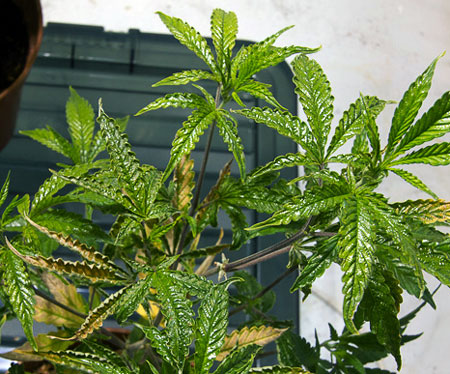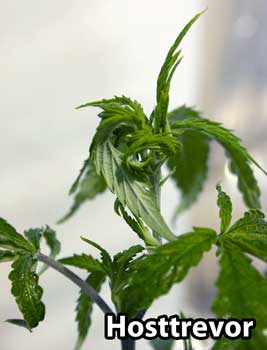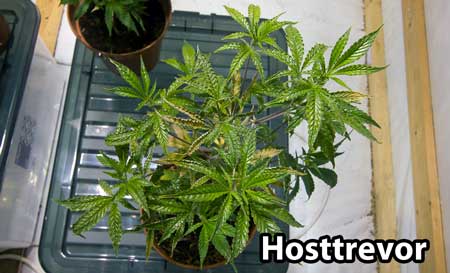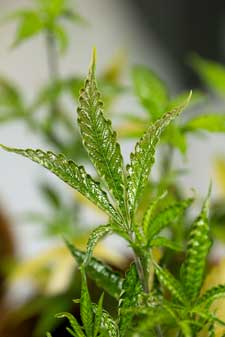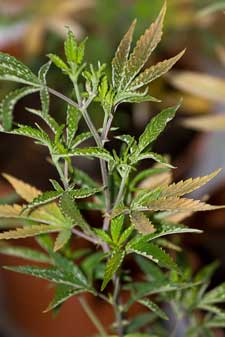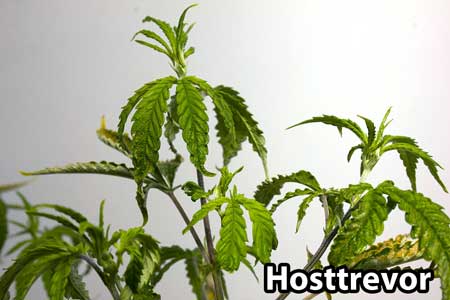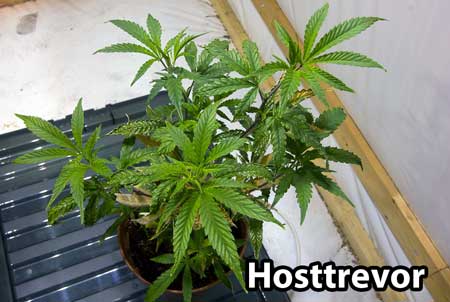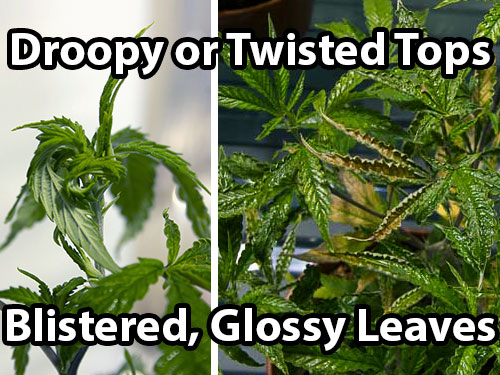
by Nebula Haze
Broad mites on your cannabis plants are so tiny they are practically impossible to spot with the naked eye, and can even be difficult to see under a microscope.
Broad Mite Symptoms:
- Bugs are so small they are difficult to see without magnification
- Under a microscope, you can see that they have 6 legs when young, and 8 legs as adults
- Symptoms are often confused for heat stress, overwatering, a pH imbalance, or root problems
- New growth may be twisted or drooping
- Leaves may be, blistered or “wet” looking
- Leaves may be turned up at the edges
- Broad mites don’t attack all parts of the plant evenly; symptoms are worse in certain spots where the infestation is concentrated
- In the flowering stage, buds may become sickly and die
With broad mites, the new growth may be twisted, blistered and “wet” looking. If your plant is flowering the buds may turn brown and die. These broad mite damage pics were taken by Hosttrevor (thank you!).
Sometimes one of the main symptoms is the newest growth is coming in twisted
Edges may turn up as if the plant is suffering from heat stress, but with broad the leaves take on a glossy, almost plastic-like appearance. Eventually affected leaves turn yellow or bronze and die.
The main way to spot an infestation is the damage they leave behind because usually the mites themselves are too small to see. They like to hang out inside inside your plants, where they can live and lay eggs without you seeing them.
Sometimes the symptoms can be confused for tobacco mosaic virus. Leaf symptoms from broad mites are also commonly misdiagnosed as overwatering, a nutrient deficiency or heat damage.
One of the biggest reasons broad mites can be so difficult to diagnose is you rarely see any signs of bugs, and you don’t see bites on the leaves. For many people, they don’t even realize a bug infestation is happening.
Sometimes top leaves droop. In this pic you can see that part of the droopy leaves are getting that blistered, wet appearance from broad mites.
The following marijuana plant has been treated for broad mites and is starting to recover. You can see the newest growth looks matte and healthy, while the damaged leaves from before still look glossy and blistered.
It’s great if your plant is starting to look healthy again, but even if your plant appears to be recovering, don’t stop on weekly treatments for at least a few weeks. The broad mites could still be there waiting to take over the plant again! They are the masters of hiding and waiting.
Unfortunately, broad mites are probably one of the hardest marijuana pests to get rid of. They lay their eggs inside the plant which makes it very difficult to kill their eggs!
Solution: How to Get Rid of Broad Mites On Cannabis
Once you’ve actually identified that you have broad mites, it’s time to get rid of them! When it comes to broad mites, a lot of the “standard” miticides are not as effective and you’ll notice these particular mites aren’t listed on the labels.
Broad mites can be one of the toughest marijuana pests to get rid of, but it can be done if you stay vigilant.
- Immediately and carefully remove infected parts of the plant – if there’s already an infestation in the tissue, you likely won’t be able to save those particular leaves/buds. Your main goal is to stop the infestation from spreading.
- Treat often – You may have to treat several times a week or even daily if you have a terrible infestation that won’t go away. This can be very difficult on your plants.
- Spray Before Lights Go Out – Whenever treating plants with a spray, do it before the lights go off so that your plant is less likely to get burned.
- Read Instructions – Make sure to read the full instructions of each bottle and follow them when treating your plants. You will save yourself a lot of big headaches.
- Repeat treatments weekly for 5 more weeks after mites are gone – After you think broad mites are completely gone, don’t stop. Treat your plant with a different treatment at least once a week for 5 additional weeks. If you don’t completely eradicate them they’ll come back with a vengeance and can be even more resistant to whatever you throw at them.
Here’s a Detailed Step-by-Step:
1.) Dispose of known infected plant matter
The parts of the plant that are already infested should be carefully removed and discarded of if possible. This will dramatically reduce the bug numbers, and help save the rest of your plant.
2.) Neem Oil
Neem Oil will leave an unpleasant taste/smell on buds when used to treat flowering plants, so don’t let this stuff get near your buds. There’s also some evidence Neem oil may be harmful to humans so use it with care. That being said, Neem oil is an all-natural remedy that is very effective against many different types of bugs and mold, including broad mites.
Neem oil can be rough on your plants so you don’t want to use it more often than you have to because your plants may suffer. However, if you get desperate treating plants daily with Neem oil can be effective at killing broad mites when nothing seems to be working.
You will need a mister (also called a “One-Hand Pressure Sprayer”) to spray all the leaves evenly since neem oil and water can separate easily. A mister helps you get full and even coverage on all parts of the plant.
3.) Essentria IC3
Essentria IC3 Insecticide is a mix of various horticultural oils that is organic and safe for humans. It is often marketed as a “bed bug killer” but it can be effective against broad mites when the plants are treated regularly. Unfortunately, it only stays effective on the plant for about 8 hours so you will want to either apply this daily or combine with other options. Foolow the directions carefully. You will need a mister (also called a “One-Hand Pressure Sprayer”) to spray all the leaves evenly.
4.) Insecticidal soaps
Fatty acid salts or insecticidal soaps can help against broad mites. They weaken the outer shell of broad mites but are safe to use on your plants and they don’t leave much of a residue which could kill beneficial bugs in your garden.
With soaps, just like horticultural oils, coverage is very important as it does not stay on your plant for long, so follow-up applications may be necessary. Although this is considered safe, avoid getting any on your buds because it can affect the taste or small.
This probably won’t get rid of broad mites on its own, but it is less harsh on your plants than some of the other options and so it can be a great way to supplement the other treatments you’re doing by bringing down their numbers.
5.) Avid
Avid miticide is strong stuff with harsh chemicals and is incredibly expensive, but it can sometimes do the job when nothing else is working. This is a systemic insecticide, which means it works by infiltrating the inside of plant tissue and killing bugs that way. Because of that, it should NOT be used in the flowering stage (you don’t want this stuff inside your buds). However, many growers report that this is the only thing that consistently works for them. Always use Avid as directed and only as a last resort. You will need a mister (also called a “One-Hand Pressure Sprayer”) to spray all the leaves evenly.
Don’t use this product more than once or twice in a row or your mites may become resistant. This should stay in your plant’s system for several weeks so this is only really suitable for young plants. If you’re going to be using systemic insecticides, switch back and forth between this and another one like Forbid. Make sure to follow the instructions.
6.) Forbid
Forbid miticide is sort of like Avid in that it is made of strong stuff with harsh chemicals and is also expensive. This is a systemic insecticide, which means it works by infiltrating the inside of plant tissue and killing bugs that way. Because of that it should only be used several weeks before the beginning of the flowering stage (you don’t want this stuff inside your buds and it can stay in the plant for weeks). However, many growers report that this can be the only thing that consistently works for them. Always use Forbid as directed and only as a last resort!. You will need a mister (also called a “One-Hand Pressure Sprayer”) to spray all the leaves evenly.
Don’t use this product more than once or twice in a row or your mites may become resistant. This should stay in your plant’s system for several weeks. If you’re going to be using systemic insecticides, switch back and forth between this and another one like Avid. Make sure to follow the instructions.
7.) Diatomaceous Earth
Diatomaceous Earth is basically fossil dust that can be sprinkled on the top of your soil, and anywhere else in your room (window sills, doorways, etc). This powder-like substance is harmless to mammals and plants but is incredibly sharp at the microscopic level. Therefore it will tear and dehydrate broad mites on physical contact. This will not get rid of an infestation but can help prevent, control, and slow things down when used effectively. When it comes to broad mites, you want to use every tool you can.
8.) Heat
Broad mites don’t like the heat above 90°F (32°C). Some growers will try to get rid of them by on small plants or clones by dunking the plants in hot water (105°F / 40°C) for 10-20 minutes. I’ve also heard of growers try to reduce their number by overheating the grow space to 115°F (46°C) for an hour. Be careful as this can be dangerous if you don’t take safety precautions, and any heat method strong enough to kill the mites will likely hurt your plants.
9.) Predatory Mites
Some types of predatory mites, like Neoseiulus type mites, love to eat broad mites. Supplementing your garden with extra predators can help bring down broad mite numbers. However, it’s not enough to fix the problem on their own and unfortunately, a lot of the other remedies on this page will also kill predatory mites.
If you don’t want to use pesticides, or want some extra help, get predatory mites to help eat all your broad mites.
10.) AgroMagen
I’m not personally familiar with this product but I’ve heard it’s effective against broad mites. Given how tough this pest can be to get rid of, I wanted to make sure I included every possible option. From what I understand you will need to spray more than once and this is best combined with at least one other treatment.
AgroMagen claims to be effective against broad mites
More Cannabis Pests, Bugs & Viruses

